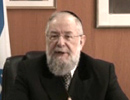Beit Midrash
- Torah Portion and Tanach
- Bamidbar
- Bamidbar
- Shabbat and Holidays
- Shavuot
- Articles about Shavuot
This year, Shabbat & Shavuot are connected, & so their respective readings must also have a direct kesher. Sefer Bamidbar contains the well-known Mitzva of Pidyon Ha-Ben, the redemption of first-born sons, still done today. More on this in a moment.
The story of Rut is a compelling one, establishing the roots (pun intended) of the Davidic dynasty & Moshiach. Its central message, along with stressing the midot of Chesed & Emuna, is two-fold: Moshiach, & Geula, can come from the least-expected of places; and each & every person, no matter their background or humble beginnings or level of knowledge, can be an essential part of the process.
But often overlooked is the "story within the story," the poignant & impressive personal journey of redemption taken by Naomi. Here is a woman that loses everything of value in her life. She had notoriety, as the wife of the prominent Elimelech, a direct descendant of Nachshon, the celebrated prince of Shevet Yehuda. She had wealth, she had respect, she had two sons who themselves were quite distinguished citizens of Bet Lechem – Efrat.
But then, in a whirlwind of tragedy, she loses it all: First, she severs her connection with friends & family by leaving Eretz Yisrael. Her children marry non-Jewish women. Her husband loses his wealth. And then, one by one, her loved ones die. Alone, adrift, stripped of her former high status, she is reduced to begging, subject to shame & humiliation from everyone she encounters.
"Don’t call me Naomi, "pleasant," she tearfully pleads, "call me Mara,"bitter."
But Naomi somehow finds the inner strength to gather up her courage & start the long trek back to respectability & new life. The first step is coming home, to Israel, despite the embarrassment this engenders. Next is reaching out, via Ruth, to her kinsman Boaz, to resume her lineage. The Megila dramatically indicates the surrogate role Rut plays on behalf of her alter-ego Naomi. When Rut lays next to Boaz, the k’tav (the way the word is written, rather than the way it is pronounced) reads, "I (Naomi) will go to the granary, & I (Naomi) will lie there." And when a child is born, the neighbors declare: "A son is born….to Naomi!" Ruth may be the body performing these actions, but Naomi is clearly the soul.
Each year, when Shavuot comes, we stand again at the foot of Har Sinai. It is a brand new revelation, another chance to accept the Torah & renew our vows, our "Shavuot" with Hashem. No matter how far we may have strayed from
the Torah or its Mitzvot, we rediscover our "Ruts" & we, too, like Naomi, have a chance at Redemption – as a person & as a People.





















